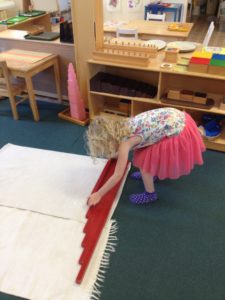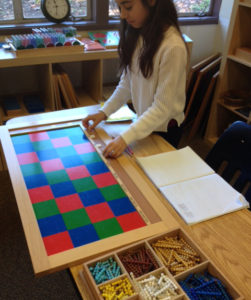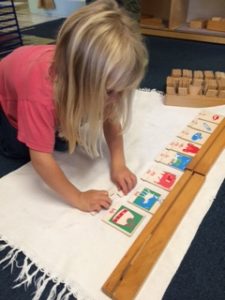Areas of Learning
Montessori classrooms, at every level, are divided into five distinct areas that focus on developing a particular facet of the child’s personality and potential. At the various levels, the specific activities evolve, but the overall characteristics of the curriculum remain the same. As in life, the various Curriculum Areas overlap and interconnect, helping the child reinforce concepts and skills over a wide range of experiences.

In Practical Life, juicing an orange builds muscle coordination and independence
PRACTICAL LIFE
This is the area of the classroom and curriculum that allows the child to orient herself to her environment. As its title implies, it is where self-help skills for everyday life are explored and practiced. As the child ages and becomes more capable and confident, the activities increase in length, complexity and refinement. The activities reflect those that might take place in and around the home, but the materials themselves are sized appropriately for each level.
The particular focus areas in the Practical Life curriculum are: grace in movement and everyday tasks, food preparation, courtesy and conflict resolution, care of self, and care of the environment.

Exploring Length
SENSORIAL
Maria Montessori understood that for a child to truly understand a particular concept, she must interact with it through her senses. Sight, touch, hearing, taste, smell provide the fundamental means by which a young person experiences the world and takes in information. By approaching and grasping concepts using the senses, and through specific exercises of comparison and classification, the child is better able to comprehend and classify the complicated and varied world in which they find themselves.
The particular focus areas in the Sensorial curriculum are: color, form, mass, tone, texture, smell, temperature, length, taste, and (at the Primary level) the beginning concepts of geometry.

Elementary child uses Checkerboard material for long division
MATHEMATICS
We are all born with a mathematical and reasoning mind, though too often children are frustrated and discouraged when they have missed a key component necessary to understand a concept. Montessori developed materials to help children not only understand but also enjoy mathematical concepts and rules, and to discover patterns in math on their own. Consistent color-coordinated materials help reinforce tricky concepts and allow the child to engage with math in a fun and concrete way.
The particular focus areas in the Mathematics curriculum are: classification, comparison, and patterning; methods of counting; decimal system concepts and mathematical processes using concrete decimal system material; math fact practice; fractions; and geometry.

Using Reading Tablets to build language skills
LANGUAGE
Language infuses and informs all the other areas of the classroom and indeed life in general. The material developed by Maria Montessori to help the young person to understand the rules and mechanics of language arts is one of the most powerful aspects of the Montessori classroom environment. The child enters a Montessori classroom for the first time with an already tremendous amount of exposure to oral and written language. Our task as adults is to help the child discover how the patterns of sound and symbol come together to communicate thoughts from one person to another.
The particular focus areas in the Language curriculum are: phonetics, vocabulary, grammar, word study, sentence analysis, and composition.

Child uses the map of North America to strengthen knowledge in geography
CULTURAL
Maria Montessori lived through two world wars and came to believe that the revolutionary educational system she discovered and developed was a powerful path towards attaining a peaceful world. Montessori understood and appreciated that human beings all have the same basic needs, but that human beings, in different places and times, have met those needs in particular, extraordinary ways. The Cultural subjects highlight the accomplishments of human understanding, and they are designed to not only awaken and inspire each individual child’s love of our world’s natural systems, but also to help them understand and appreciate humanity’s role in comprehending the universe.
The particular focus areas in the Cultural curriculum are: Geography, Zoology, Botany, Physical Science, History, Anthropology, Visual Arts, Music, Dramatic Arts, and the Fundamental Needs of Mankind

